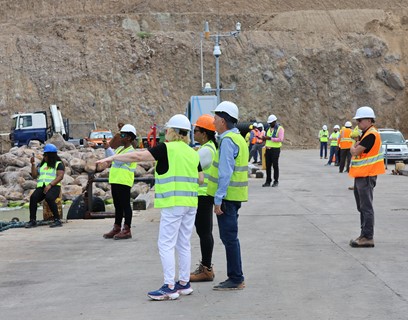
Port Louis, 28 November—The Intergovernmental Committee for the Safeguarding of the Intangible Cultural Heritage, meeting in Mauritius until 1 December, inscribed nine elements on the Representative List of the Intangible Cultural Heritage of Humanity.
The Representative List seeks to enhance visibility for the traditions and know-how of communities without recognizing standards of excellence or exclusivity.
The newly inscribed elements are:
Austria; Czechia; Germany; Hungary; Slovakia—Blaudruck/Modrotisk/
Azerbaijan, Kazakhstan, Turkey—Heritage of Dede Qorqud/Korkyt Ata/Dede Korkut, epic culture, folk tales and music—The epic culture, folk tales and music of Dede Qorqud/Korkyt Ata/Dede Korkut (Grandfather Qorud) are based on 12 heroic legends, stories and tales and 13 traditional musical compositions transmitted orally through performances with specific cultural codes and musical compositions. The legendary character of Dede Qorqud appears in each story as an old man whose words, music and expressions of wisdom relate to traditions associated with birth, marriage and death. The practice contains profound knowledge about the history and culture of Turkic-speaking communities and is practised and sustained on a wide variety of occasions.
Belarus—Celebration in honor of the Budsla≈≠ icon of Our Lady (Budsla≈≠ fest)—The Budsla≈≠ Fest takes place in Budsla≈≠ village, in the Minsk region. Every early July since the 17th century, tens of thousands of pilgrims from all over Belarus and other countries come to Budsla≈≠ to participate in the celebrations of the Budsla≈≠ Icon of Our Lady, who is said to have appeared to believers in Budsla≈≠ in July 1588. Taking pride in the relic, locals offer pilgrims a warm welcome and invite them to share meals with them in their homes.
Bosnia and Herzegovina—Picking of iva grass on Ozren mountain—Every year, on 11 September, the day of the beheading of St. John the Baptist, inhabitants of villages around Ozren Mountain go up to Gostilj to pick Iva grass before assembling in smaller groups to play, dance and sing traditional music. In the afternoon, Orthodox priests consecrate the Iva. Iva is used to cure and prevent disease and the practice helps preserve traditional costumes, songs and dances. Several local associations invite similar organizations from other regions to partake in the tradition.
China—Lum medicinal bathing of Sowa Rigpa, knowledge and practices concerning life, health and illness prevention and treatment among the Tibetan people in China—Lum Medicinal Bathing of Sowa Rigpa is a practice developed by the Tibetan people as part of a life view based on the five elements and a view of health and illness centred on three dynamics (Lung, Tripa and Pekan). In Tibetan, ‘Lum’ indicates the traditional knowledge and practice of bathing in natural hot springs, herbal waters or steams to adjust the balance of body and mind, ensure health and treat illness. The element plays a key role in improving health conditions and promoting respect for nature.
Croatia—Meƒëimurska popevka, a folksong from Meƒëimurje—Meƒëimurska popevka, a folksong from the Meƒëimurje region, was historically predominantly sung by female soloists. Nowadays, it is performed by individuals and groups, men and women, in vocal, vocal-instrumental, instrumental, monophonic and multipart renditions, as a musical genre incorporated into the dance. The element is practised in a broad range of social contexts, from solitary music-making to family and community happenings, and most inhabitants will have experienced popevka on numerous occasions throughout their lives.
Croatia, Cyprus, France, Greece, Italy, Slovenia, Spain, Switzerland—Art of dry stone walling, knowledge and techniques—The art of dry stone walling concerns the art of building by stacking stones upon one another, without using any other materials except, in some case, dry soil. This know-how is preserved in rural communities where the practice is deeply rooted, and among construction industry professionals. Dry-stone structures have shaped numerous and diverse landscapes with a variety of constructions used as dwellings, for farming and animal husbandry. Such structures testify to the methods used by people from prehistory to the present in organizing their living and working space by optimizing local natural and human resources.
Cuba—Festivity of Las Parrandas in the centre of Cuba—Held for the first time in 1820 in the town of Remedios, the Festivity of Las Parrandas is a cultural competition now celebrated by 18 communities in the centre of Cuba. During the competition, each town is divided into two competing parties or neighbourhoods, with ‘spies’ attempting to spoil the opposing neighbourhood’s surprise on the night of the festivity. The festivities combine tradition and modernity and involve a wide range of expressions, including crafts, designs, costumes, music, pyrotechnics and woodwork.
France— The skills related to perfume in Pays de Grasse: the cultivation of perfume plants, the knowledge and processing of natural raw materials, and the art of perfume composition—The skills used in perfume production in Pays de Grasse cover three areas: the cultivation of perfume plants, the knowledge and processing of natural raw materials, and the art of perfume composition. Perfume plant cultivation involves a wide range of technical skills and specific knowledge concerning, for instance, nature, soil, weather, plant physiology and horticulture. The inhabitants of Grasse have acquired and helped pefect these techniques whose knowledge is mostly transmitted informally through a long learning process that still takes place primarily in local perfumeries.
Inscriptions are expected to continue tomorrow, 29 November.


